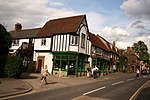Dunton Green railway station
Former South Eastern Railway (UK) stationsRailway stations in Great Britain opened in 1868Railway stations in KentRailway stations served by SoutheasternUse British English from August 2015

Dunton Green railway station is on the South Eastern Main Line in England, serving the village of Dunton Green, Kent. It is 20 miles 46 chains (33.1 km) down the line from London Charing Cross and is situated between Knockholt and Sevenoaks stations. Trains calling at the station are operated by Southeastern.
Excerpt from the Wikipedia article Dunton Green railway station (License: CC BY-SA 3.0, Authors, Images).Dunton Green railway station
Station Approach,
Geographical coordinates (GPS) Address Website External links Nearby Places Show on map
Geographical coordinates (GPS)
| Latitude | Longitude |
|---|---|
| N 51.2966 ° | E 0.1713 ° |
Address
Dunton Green
Station Approach
TN13 2XD , Dunton Green
England, United Kingdom
Open on Google Maps







